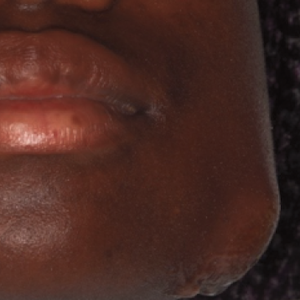Transient cutaneous hypomelanosis after cryoanesthesia

HTML: 10
All claims expressed in this article are solely those of the authors and do not necessarily represent those of their affiliated organizations, or those of the publisher, the editors and the reviewers. Any product that may be evaluated in this article or claim that may be made by its manufacturer is not guaranteed or endorsed by the publisher.
A superficial skin abscess in a young black female patient was incised after cryoanesthesia with tetrafluoroethane spray. A hypopigmented area was found at the first follow-up visit in the treated skin area; complete repigmentation occurred during the next 4 months. There are no other similar reported cases in the literature. Since long duration and possibly permanent hypopigmentation can occur after cryoanesthesia with tetrafluoroethane, especially in black people, this technique should be used with extreme caution.
Wang X, Wu X, Liu K, et al. Topical cryoanesthesia for the relief of pain caused by steroid injections used to treat hypertrophic scars and keloids. Medicine 2017;96:e8353.
Hameed NN, Sargod SS, Bhat SS, et al. Effectiveness of precooling the injection site using tetrafluorethane on pain perception in children. J Indian Soc Pedod Prev Dent 2018;36:296-300.
Ueno T, Tsuchiya H, Mizogami M, Takakura K. Local anesthetic failure associated with inflammation: verification of the acidosis mechanism and the hypothetic participation of inflammatory peroxynitrite. J Inflamm Res 2018;1:41-8.
Bilsin E, Güngörmüş Z, Güngörmüş M. The effıcacy of external cooling and vibration on decreasing the pain of local anesthesia injections during dental treatment in children: a randomized controlled study. J Perianesth Nurs 2020;35:44-7.
Bose S, Garg N, Pathivada L, Yeluri R. Cooling the soft tissue and its effect on perception of pain during infiltration and block anesthesia in children undergoing dental procedures: a comparative study. J Dent Res Dent Clin Dent Prospects 2019;13:159-65.
Kuflik E.G. Cryosurgery updated. J Am Acad Dermatol 1994;31:925–46.
Zimmerman EE, Crawford P. Cutaneous cryosurgery. Am Fam Physician 2012;86:1118-24.
Kumar S, Bhat GS, Bhat KM. Comparative evaluation of gingival depigmentation using tetrafluoroethane cryosurgery and gingival abrasion technique: two years follow up. J Clin Diagn Res 2013;7:389-94.
Kumar S, Bhat GS, Bhat KM. Effectiveness of cryogen tetrafluoroethane on elimination of gingival epithelium and its clinical application in gingival depigmentation-histological findings and case series. J Clin Diagn Res 2013;7:3070-2.
Cook DK, Georgouras K. Complications of cutaneous cryotherapy. Med J Aust 1994;161:210–3.
Graham GF. Cryosurgery. Clin Plast Surg 1993;20:131–47.
Burge SM, Bristol M, Millard PR, Dawber RP. Pigment changes in human skin after cryotherapy. Cryobiology 1986;23:422-32.
Copyright (c) 2022 the Author(s)

This work is licensed under a Creative Commons Attribution-NonCommercial 4.0 International License.
PAGEPress has chosen to apply the Creative Commons Attribution NonCommercial 4.0 International License (CC BY-NC 4.0) to all manuscripts to be published.





 https://doi.org/10.4081/dr.2022.9528
https://doi.org/10.4081/dr.2022.9528



